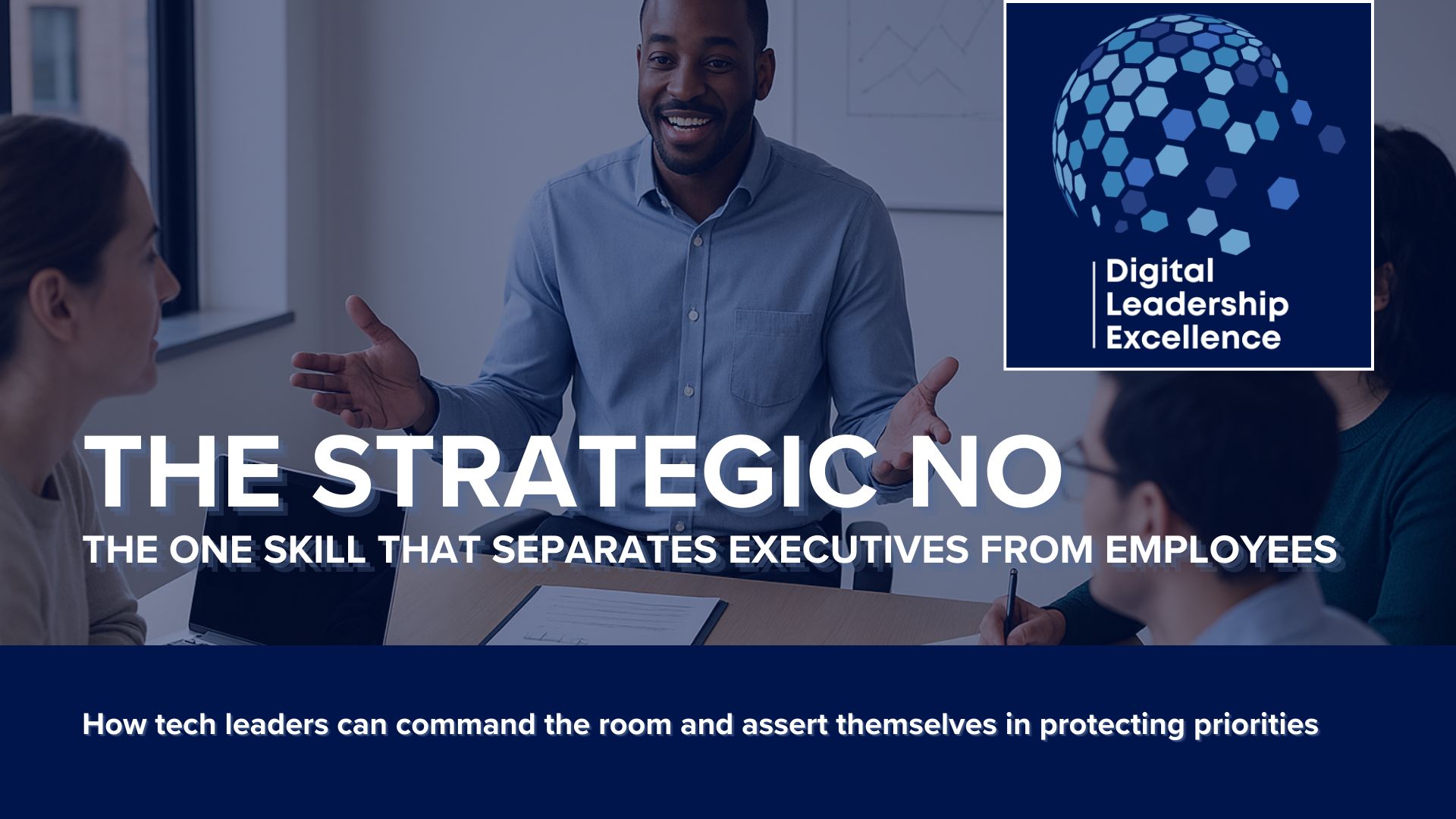- Digital Leadership Excellence
- Posts
- #55 The Strategic No: The One Skill that separates Executives from Employees
#55 The Strategic No: The One Skill that separates Executives from Employees
How tech leaders can command the room and assert themselves in protecting priorities

Greetings, and welcome to Digital Leadership Excellence — Your trusted weekly guide to excelling in tech leadership, delivering results, and thriving with clarity and purpose. In every issue, we provide insights into winning strategies, growth tactics, and practical solutions, designed to support both current and aspiring technology leaders navigating the ever-evolving digital world.
1.0 Introduction
You say yes to everything. You accommodate every request. You avoid every conflict.
And you wonder why you're not getting promoted.
Here's the truth nobody wants to tell you.

2.0 The People-Pleasing Trap
Most technology professionals build their careers on being helpful. They become the go-to person for any technical need, the reliable executor who never says no.
This strategy works brilliantly early in your career. Being helpful gets you noticed, trusted, and valued.
But eventually helpfulness becomes a ceiling instead of a ladder.
Why "Yes" Stops Working
Here's what happens when you can't say no:
Your time gets fragmented across low-impact activities. Every small request you accept is strategic work you can't complete.
Your priorities become other people's priorities. When you accommodate everything, you control nothing.
Your boundaries disappear. People learn they can interrupt you, overload you, and redirect you without consequences.
Your strategic thinking suffers. Constant reactive work prevents proactive planning and innovation.
Your authority erodes. Leaders who say yes to everything appear to have no judgment about what matters.

The Strategic No Framework
Strategic leaders understand that saying no isn't negative. It's protective. It's not rejection. It's selection.
Here's how they think differently:
They protect their strategic capacity. Every hour spent on non-strategic work is an hour not spent on executive-level thinking.
They view requests through business impact. Not all requests are created equal. Some drive business outcomes. Others just create busy work.
They understand that boundaries create respect. People value what's scarce. When your time is unlimited, it becomes worthless.
They use no to create space for yes. Declining low-impact requests creates capacity for high-impact opportunities.
3.0 The Four Types of No
Type 1: The Redirect No
That's not the best use of my time, but here's who can help you.
Use when: The request is legitimate but not strategic for your role.
Example: "I won't be able to troubleshoot that server issue, but Marcus on the infrastructure team is the expert for those problems."
Type 2: The Alternative No
I can't do that, but I can do this instead.
Use when: You want to help but need to control the scope.
Example: "I can't build that custom dashboard, but I can show you how to use our existing analytics tools to get the data you need."
Type 3: The Timeline No
I can't do that now, but I can address it in Q2.
Use when: The request has merit but conflicts with current priorities.
Example: "That integration project isn't possible this quarter given our security audit deadlines, but let's schedule it for February."
Type 4: The Strategic No
That doesn't align with our current priorities.
Use when: The request pulls you away from strategic objectives.
Example: "Building that one-off report doesn't support our data standardization initiative. Let's focus on solutions that scale."

4.0 The Authority Equation
Your authority as a leader is directly proportional to your selectivity about commitments.
High selectivity = High authority
Low selectivity = Low authority
This isn't about being difficult. It's about being strategic.
Why Technology Leaders Struggle With No
Technical Background Bias
Technology professionals are trained to solve problems. Every request feels like a problem to solve rather than a priority to evaluate.
Expertise Trap
When you can do something well, people assume you should do it. Your competence becomes your cage.
Relationship Fears
Technology leaders often worry that saying no will damage relationships with internal customers.
Lack of Business Context
Without clear strategic priorities, every request seems equally important.

The Assertiveness Paradox
The more selectively you say yes, the more valuable your yes becomes.
The more strategically you say no, the more respect you earn.
The more you protect your time, the more impact you create.
5.0 The Implementation Playbook
The mindset surrounding the “strategic no” is critical…but here’s how to implement it.
The SHIELD Framework
I've developed a five-step framework for implementing strategic no without damaging relationships:
S - Scan for Strategic Alignment
H - Honor the Request
I - Investigate Alternatives
E - Express Your Decision
L - Link to Larger Priorities
D - Direct to Solutions
Step 1: Scan for Strategic Alignment
Before responding to any request, evaluate it against your strategic priorities.
The Three-Filter Test:
Does this advance our business objectives?
Does this require my specific expertise?
Does this create leveraged impact?
If the answer to all three is no, you have a strategic no opportunity.
Step 2: Honor the Request
Acknowledge the validity of the request before declining it.
Poor approach: "I can't do that."
Strong approach: "I understand why this is important to you..."
This shows you're not dismissing their needs, just prioritizing strategically.
Step 3: Investigate Alternatives
Before saying no, explore whether there's a better solution.
Questions to ask:
What's the underlying business need?
Who else could address this?
Is there an existing solution we're overlooking?
Could we solve this more strategically?
Step 4: Express Your Decision
Communicate your no clearly and confidently.
Weak language: "I probably can't..." "I don't think I can..."
Strong language: "I won't be able to..." "That's not something I can take on..."
Certainty creates respect. Uncertainty invites negotiation.
Step 5: Link to Larger Priorities
Connect your no to bigger strategic objectives.
Example: "I'm focusing my time on the customer data platform project, which is critical for our Q1 revenue goals."
This shows you're not being arbitrary. You're being strategic.
Step 6: Direct to Solutions
Whenever possible, provide alternative paths forward.
Examples:
Recommend someone else who can help
Suggest existing tools or processes
Offer to help them find the right resource
Propose a different timeline when you could assist

6.0 Real-World Scenarios
Scenario 1: Last-Minute Reporting Request
Request: "Can you create a custom report for tomorrow's board meeting?"
Strategic No Response: "I understand this is urgent for the board presentation. I won't be able to create a custom report by tomorrow given my security audit commitments, but our standard quarterly dashboard covers most of this data. Let me connect you with Sarah, who can pull the additional metrics you need."
Scenario 2: Non-Strategic Project Assignment
Request: "We need you to lead the office wifi upgrade project."
Strategic No Response: "I appreciate you thinking of me for this project. This infrastructure work isn't the best use of my strategic planning time right now. Marcus has the technical expertise for wifi implementations and would deliver better results faster. I'm focusing on the digital transformation roadmap that supports our expansion goals."
Scenario 3: Endless Meeting Invitations
Request: "Can you join our weekly vendor review meetings?"
Strategic No Response: "I understand you want technical input on vendor decisions. I won't be able to attend weekly meetings, but I'm happy to review critical vendor proposals asynchronously and provide technical assessment. This gives you my expertise without pulling me away from the architecture planning that's driving our platform modernization."

Advanced Assertiveness Techniques
Technique 1: The Preemptive No
Set boundaries before requests come in.
Example: "I'm protecting my mornings for strategic planning, so I won't be available for meetings before 10 AM."
Technique 2: The Systematic No
Create clear criteria for what you will and won't do.
Example: "I only take on projects that directly impact our customer experience metrics."
Technique 3: The Collaborative No
Turn your no into a strategic discussion.
Example: "Instead of building another custom solution, let's discuss how this fits into our platform strategy."
Building Your No Muscle
Week 1: Practice Small Nos
Start with low-stakes situations to build confidence.
Week 2: Set One Clear Boundary
Choose one type of request you'll systematically decline.
Week 3: Use the SHIELD Framework
Apply the full framework to one significant request.
Week 4: Track Your Impact
Measure how strategic nos create space for strategic work.

Common Mistakes to Avoid
Mistake 1: Over-explaining Your No
Give clear reasoning, not extensive justification.
Mistake 2: Apologizing for Strategic Decisions
Don't apologize for protecting your priorities.
Mistake 3: Leaving People Hanging
Always provide alternative paths forward when possible.
Mistake 4: Being Inconsistent
Apply your strategic criteria consistently to build credibility.
Measuring Success
You'll know you've mastered strategic no when:
People stop making non-strategic requests of you
Your time becomes more focused on high-impact work
Others seek your opinion on priorities, not just execution
Your strategic projects get more attention and resources
You feel more in control of your schedule and impact

7.0 The Leadership Transformation
Strategic no isn't just about time management. It's about leadership identity.
When you master strategic no, you transform from helpful employee to strategic leader.
You stop being the person who accommodates everything and become the person who shapes priorities.
Your Next Steps
This week: Apply the three-filter test to every request you receive.
Next week: Use the SHIELD framework to decline one non-strategic request.
This month: Set three clear boundaries about what you will and won't do.
The Bottom Line
Your ability to say no strategically determines your ability to say yes meaningfully.
The technology leaders who advance aren't the most helpful. They're the most selective.
Master this skill, and you'll master strategic leadership.
Robert
P.S. - The hardest part about saying no isn't the technique. It's overcoming the belief that being helpful is the same as being valuable. In leadership, selectivity is everything.

Robert Castle
Founder | DIGITAL LEADERSHIP EXCELLENCE
What did you think of today’s Newsletter?select below |
Reply